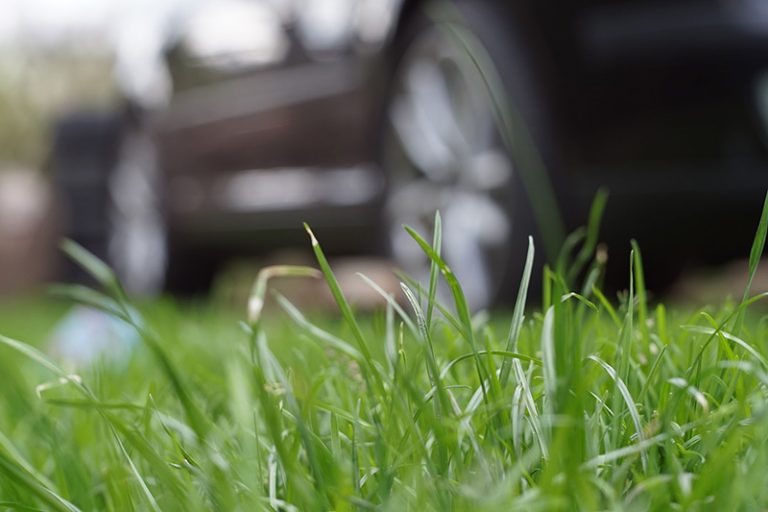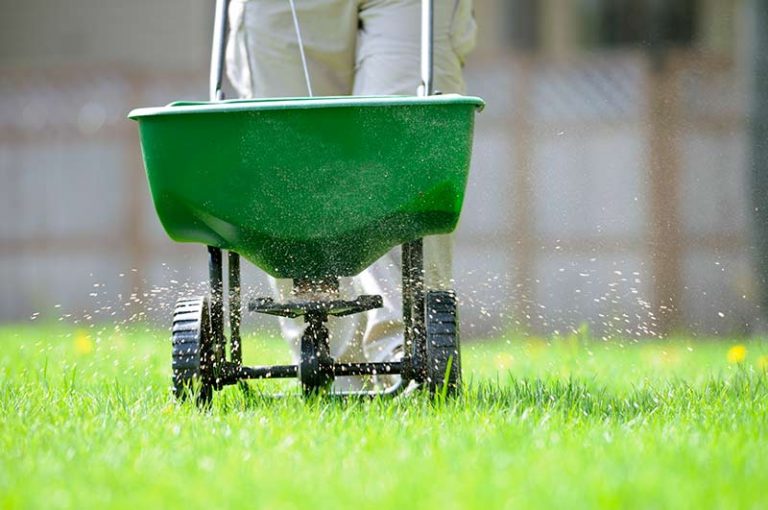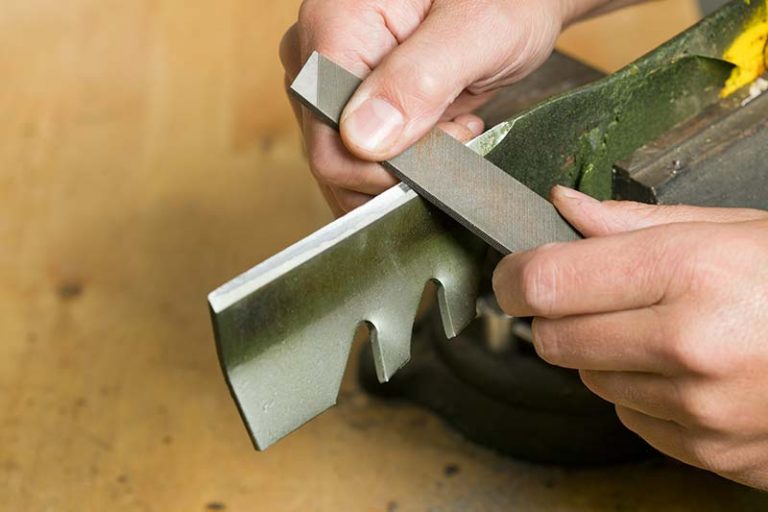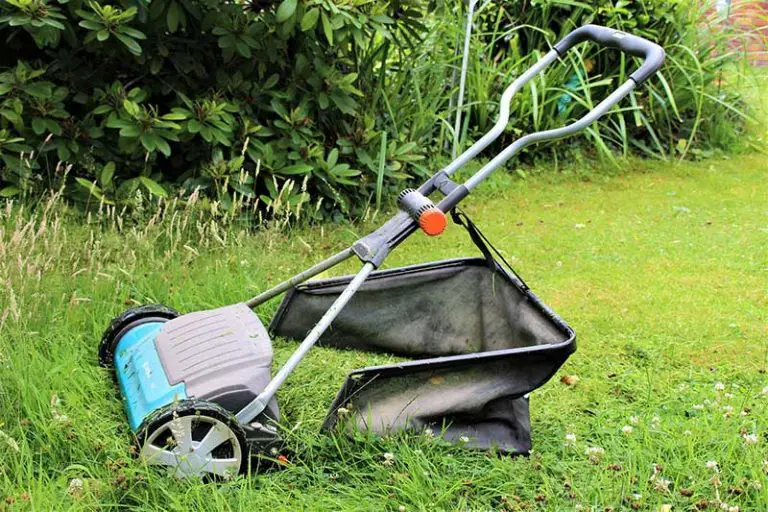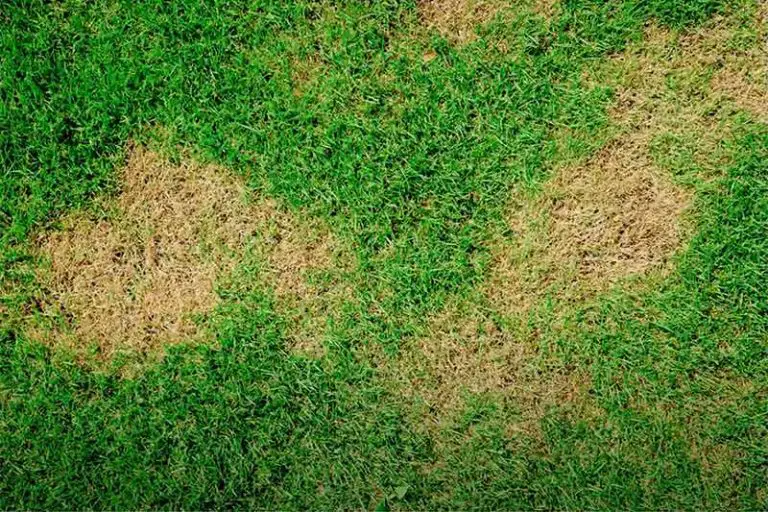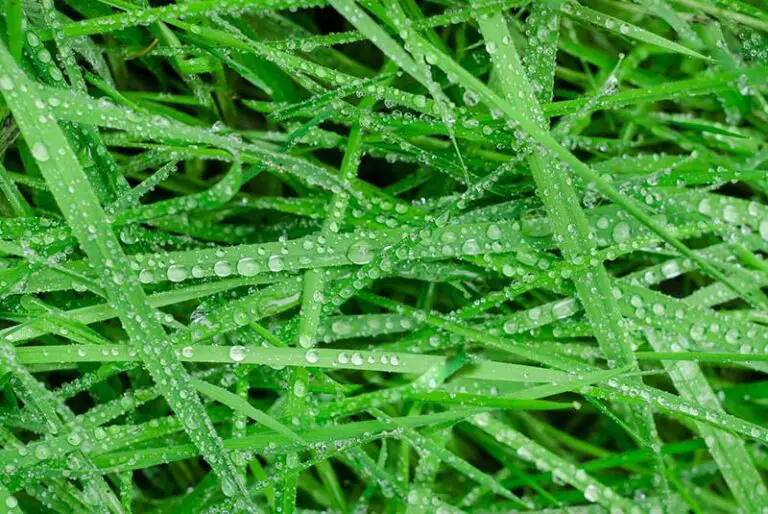Mowing After Overseeding: The Best Time to Cut Your Lawn
One of the most important elements of aftercare for new grass is knowing when to mow for the first time. Mow too soon, and you risk ripping up or trampling the tender seedlings before they’re established in the soil. Mowing too late, on the other hand, will leave you with too much foliage to take off.
After overseeding, you should wait between 14 and 28 days to mow for the first time. This gives the grass enough time to germinate and establish the roots it needs to withstand the mowing process. For this first mow, you should cut the grass to the tallest height in the recommended range for its species.
Can I Mow the Day After Overseeding?
In theory, you can mow the day after overseeding without harming the seed. With that said, this is not the best practice when it comes to mowing and overseeding. You should instead incorporate mowing into the preparation of your lawn before sowing your grass seed.
Under ideal conditions, grass seeds can sprout within 48 hours of being sown. If you mow over the seed before it sprouts, e.g. mow the day after overseeding, it won’t harm the seed; however, it will damage any seed that has begun to sprout early. Young seedlings are still establishing roots in the soil and are unable to withstand the stress of mowing. Beyond 2 days, you should absolutely avoid mowing until the seed finishes germination.
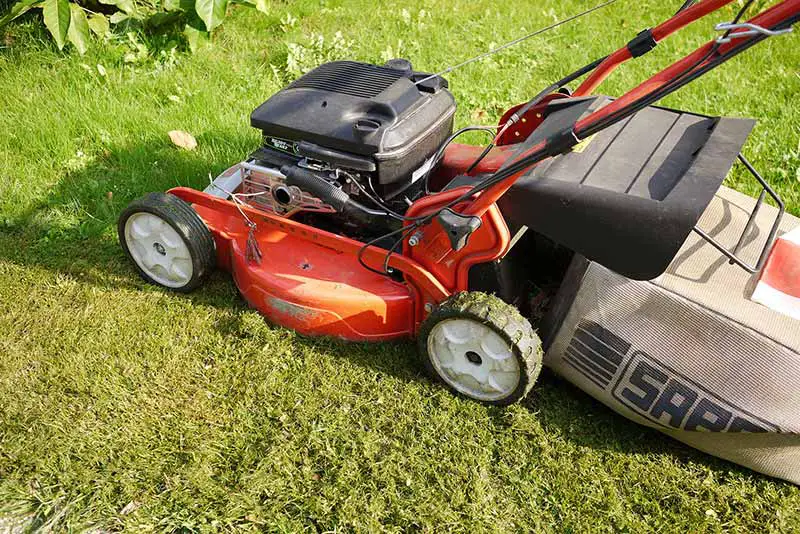
When to Mow After Overseeding
Generally speaking, you’ll need to wait somewhere between 2 and 4 weeks before you mow after overseeding. You need to allow enough time for your grass seedlings to fully establish themselves in the soil. Under the right conditions, most grass species will typically take this long to germinate and become established.
How soon you can mow after overseeding will therefore depend on the time it takes your grass seed to germinate. Many factors can affect grass seed germination times, including the soil conditions, weather conditions, and the amount of sunlight the planting area receives.
Grass seed will germinate the fastest if you plant it into well-prepared, fertile soil in an area with full access to the sun. It’s also crucial to plant the grass seed at the right time of year for its species; warm-season grass should be planted in the late spring to early summer, while cool-season grass requires planting in the spring or fall. Planting your grass seed under ideal conditions gives it the best chance of a fast germination, allowing you to mow after overseeding sooner.
Timeline For Overseeding and Mowing Lawn
Prepare Lawn for Overseeding
Before sowing your grass seed, you should first prepare the lawn for the overseeding process. This ensures you’re laying the seed under the best conditions to promote fast and healthy germination. To prepare your lawn for overseeding, you’ll need to aerate, dethatch, and mow the grass.
Aerating before overseeding is one of the most effective ways to maximize the success of your new grass seed. The best way to aerate your lawn is to use a core aerator to pull plugs of soil from the turf; the holes left behind by the process will allow your grass seed to fall deeper into the ground. This process also helps to break up the thatch layer
To further improve seed-to-soil contact, you should also dethatch or scarify the lawn before overseeding. If your lawn only has a light amount of thatch, dethatch the lawn with a rake or dethatching mower attachment. If your lawn has a severe amount of thatch, scarification is more appropriate as this is simply a deeper form of dethatching.
Once you sufficiently aerate and dethatch the lawn, you’ll then need to mow the grass before overseeding. Mow as short as possible according to the best height range for your current grass species, i.e. to a height between 1 and 1.5 inches. This will improve seed-to-soil contact even further by allowing more of the grass seed to reach the soil surface.
Day 1: Overseed Lawn
Choose a suitable grass seed for overseeding that will be compatible with your current grass and climate. Using a drop spreader or broadcast spreader, fill the hopper of your spreader with your chosen seed. Adjust the settings on your spreader in accordance with the seeding rate listed on your grass seed’s packaging. Overseed your lawn, spreading the seed evenly throughout the areas you want to thicken.
Days 1 to 7: Water Lawn 3 Times Per Day
Immediately after overseeding your lawn, water the planting area thoroughly to moisten the top ¼ inch of soil. You’ll need to keep this top ¼ inch of turf consistently moist throughout the first week after seeding; this will require you to water the lawn in short regular intervals throughout the day. Increase the frequency of your watering sessions if you go through a period of dry or hot weather.
Days 7 to 14: Reduce Frequency of Watering Sessions
As the grass seedlings begin to establish themselves in the soil, you should reduce the frequency of your watering sessions, while increasing the amount of water you add each time. This is to encourage the grass seedlings to develop deeper roots.
Days 14 to 28: Mow For First Time After Overseeding
After 14 to 28 days, your grass will be ready for its first mow after overseeding. If you’re unsure whether your grass is ready for mowing, you can conduct a pull test on the seedlings; this simply involves pulling on the grass shoots gently and gauging their resistance. If the seedlings are easy to pull out of the soil, it’s too soon to mow.
How to Mow After Overseeding
When your lawn is ready for the first mow after overseeding, follow these steps to promote the health of your new grass.
1. Use Light Lawn Mower
For the first mow after overseeding, it’s best to use the lightest lawn mower you have access to. If you’re working on a small to medium-sized planting area, a simple push mower will do the job without damaging the young grass.
2. Make Sure Lawn Mower Blades Are Sharp
Before using your lawn mower, you need to make sure that the mower blades are sharp. Dull mower blades are terrible for both new and mature grass; when dull, the blades have a tearing action on the grass rather than achieving a clean cut. This leaves the grass more susceptible to stress from fungal diseases and pests.
You need to sharpen your mower blades every 20 to 25 hours of usage. If they seem dull, sharpen your mower blades using a hand file or take them to a professional to be sharpened for you.
3. Wait For Dry Weather
Hold off on your first mow after overseeding until the lawn is completely dry. Water from rainfall or irrigation will soften the soil; when you mow for the first time, the young seedlings will lack the roots necessary to keep them anchored in the softened ground.
Mowing wet grass may also leave your lawn and seedlings more vulnerable to the development of fungal lawn disease. Furthermore, wet grass clippings can clog your lawn mower blades, potentially causing your mower to fail. For all of these reasons, it’s best to wait until the lawn is completely dry before mowing after overseeding.
4. Decide Whether to Bag or Mulch Grass Clippings
When mowing your lawn, you have two options; you can either bag the grass clippings or leave them on the lawn as grass clipping mulch. The answer to whether it’s best to mulch or bag grass clippings will depend on your particular circumstances.
You should bag grass clippings if you’re overseeding to fill bare patches on the lawn. Mulching or discharging the grass clippings onto the lawn may lead to clumping, and clumpy piles of grass clippings will smother your patches of new seedlings. It will also be necessary to bag grass clippings if your lawn is showing any signs of fungal disease.
It may be more beneficial to mulch grass clippings if you’re overseeding to fix an entire lawn with severe patching. As the grass clippings decompose, they act as a slow-release fertilizer, supplying the lawn with a steady stream of nutrients. With that said, in most cases, it will be more suitable to bag the clippings during mowing using a bagging attachment.
5. Cut Grass As Tall As Possible
When conditions are right, i.e. the grass is fully established and the lawn is dry, you can get mowing. Adjust your mower deck height to cut the grass as tall as possible according to its ideal cutting height range.
Mowing the grass as tall as possible is best practice at this stage. Cutting the grass too short will encourage it to grow shorter roots, resulting in weaker grass plants. By cutting the grass to a taller height, you instead encourage it to establish longer, more extensive root systems.
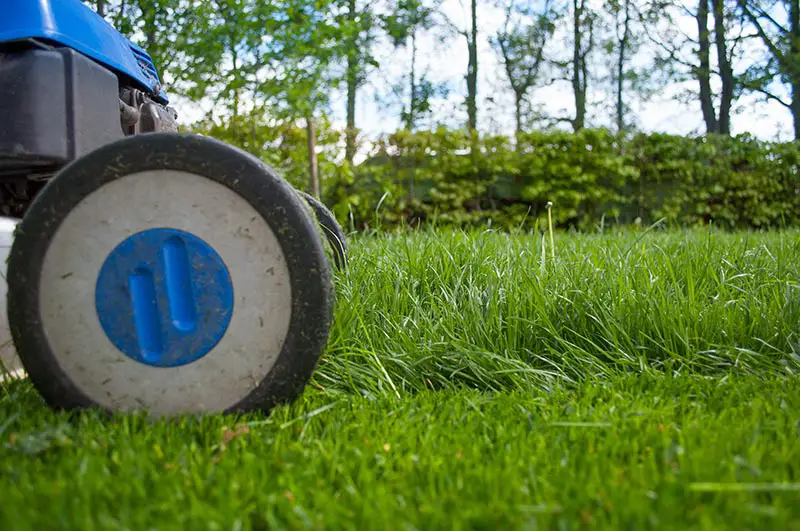
Best Height to Mow Grass After Overseeding
The best height to mow grass after overseeding is the tallest length possible for its species. Ideal mowing heights vary between grass species, as demonstrated in the table below.
| Grass Species | Best Mowing Height Range |
| Bahia grass | 2.5 to 4 inches |
| Bermuda grass | 0.5 to 2 inches |
| Buffalo grass | 1.5 to 4 inches |
| Centipede grass | 1 to 2.5 inches |
| Fine fescue | 1.5 to 4 inches |
| Kentucky bluegrass | 0.75 to 3.5 inches |
| Kikuyu grass | 1 to 2 inches |
| Perennial ryegrass | 0.75 to 2.5 inches |
| St. Augustine grass | 1 to 3 inches |
| Tall fescue | 1 to 3 inches |
| Zoysia grass | 0.5 to 3 inches |
According to the ideal mowing height range for your grass species, cut the grass to the tallest height possible. As we’ve explained, mowing the grass to a taller height will encourage the seedlings to grow deeper root systems. It’s also important not to mow the grass too short to avoid shocking the tender grass’ developing roots.
When continuing on with your regular mowing schedule, you should base how often you mow on the grass’ height, following the ⅓ rule; this is the principle that you should never remove more than ⅓ of the grass’ total height in one mowing session. You should therefore allow your grass to grow 1.3x taller than its recommended height before mowing.

